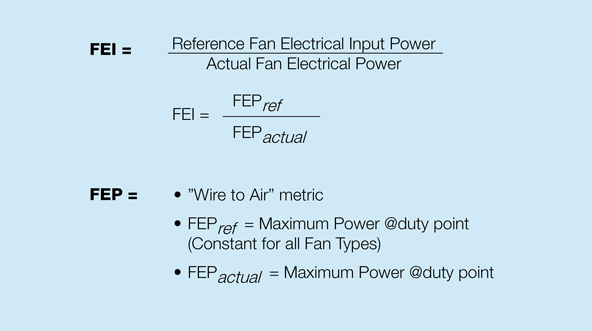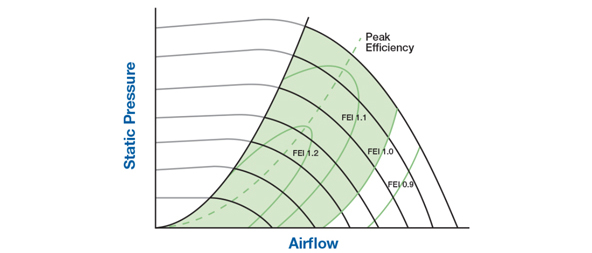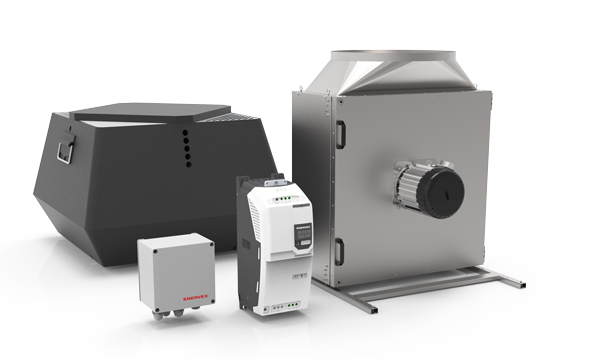
The Fan Energy Index (FEI) is a quantitative measure developed to assess the energy efficiency of fan systems within HVAC applications. FEI, while a relatively technical concept, can be distilled into a simple idea: it measures how energy-efficient a fan is in real-world operating conditions. The FEI metric aims to prevent market behaviors focused on initial costs that could lead to less efficient choices.
As the industry leans into sustainability and decarbonization, FEI has emerged as a critical tool. Created by the Air Movement and Control Association (AMCA), FEI-rated or certified products are increasingly sought after. This surge in interest is a response to a global call for more environmentally friendly and energy-efficient buildings.
Before FEI, there was the Fan Efficiency Grade or FEG. Initially introduced by the dynamic ASHRAE 90.1 standard – FEG set a foundational benchmark for fan efficiency by rating fans based on peak performance, determined through specific airflow and pressure criteria. FEG focused solely on a fan's optimum performance point, neglecting the broader operational spectrum.
Crucially, it failed to consider the efficiency of other integral components like motors and drives. This meant that while a fan could score high on the FEG scale, it might not be the most energy-efficient choice in practical scenarios, especially for smaller fans or non-ducted applications.
With the latest ASHRAE 90.1-2022 iteration, there's a pivotal shift in evaluating fan efficiency, moving from FEG to the Fan Energy Index (FEI).
In contrast to the narrow focus of FEG, FEI ushers in a more holistic and comprehensive evaluation of fan efficiency. FEI's strength lies in its ability to consider the entire fan system. This includes not just the fan itself but also the motors, drives, and controls integral to its operation.
The Fan Energy Index (FEI) is fundamentally a ratio comparing the energy efficiency of two types of fans: the actual fan in use or under consideration, and a reference fan, which is a theoretical model representing the pinnacle of efficiency attainable with contemporary technology.
This can be represented in a simple formula:

In this formula, 'power input' refers to the electrical power consumption of the fan, measured in kilowatts (kW). It's crucial to evaluate this power usage under identical operational conditions for both fans. These conditions, known as the 'duty point,' ensure a fair comparison.

The 'duty point' is a set of specific operational conditions under which both the actual and the reference fan are evaluated. These conditions include:
This parameter quantifies the volume of air a fan can circulate, typically measured in cubic feet per minute (CFM). It's an essential indicator of a fan's capacity to handle air. A higher CFM means the fan can move a larger volume of air, making it suitable for larger spaces or applications requiring more air circulation.
This refers to the rise in air pressure caused by the fan's operation, usually quantified in inches of water gauge (IWG). It's a critical measure of the fan's power to push air through a space or a system. Higher pressure increases indicate a more powerful fan capable of moving air effectively, even against resistance, like in duct systems or through filters.
The density of the air being moved by the fan can significantly influence its performance. Understanding air density is crucial for accurate and efficient fan operation in different environmental conditions. Air density changes with variations in temperature and humidity – for example, cooler or more humid air is denser. Denser air requires more energy to move, affecting the fan's efficiency and power requirements.
The speed of the fan blades, measured in rotations per minute (RPM), directly impacts the fan's ability to move air and create pressure. Different fan speeds can alter both the airflow rate and the pressure increase.
A higher RPM typically results in increased airflow and pressure, but it can also lead to higher energy consumption and noise levels. Selecting the appropriate fan speed is vital for balancing performance with energy efficiency and operational considerations.
Consider the FEI value as a clear indicator of a fan's efficiency in relation to a standard reference model:
For engineers and architects, FEI represents more than just a number. It's a guide to designing buildings that are not only efficient but also cost-effective and compliant with emerging standards.
With the Department of Energy recognizing the concept and jurisdictions incorporating it into energy codes, FEI is fast becoming a benchmark in building design. The inclusion of FEI in the latest ASHRAE energy standards (ASHRAE 90.1 2022) underlines its growing relevance.
For example, selecting fans with an FEI value greater than 1.0 is recommended, as these fans exceed industry standards, providing enhanced energy savings and performance. This approach is particularly vital in projects targeting high energy efficiency, such as those seeking green building certifications or adhering to strict energy codes.

Picture: Park Potomac Place, Potomac, Washington DC.
In the complex environment of multi-story, multi-family buildings, effective air management is not just a luxury but a necessity for resident comfort, health, and environmental sustainability. Each unit and floor may have different ventilation requirements based on its size, orientation, and occupancy. Choosing high FEI-rated exhaust systems is a critical move in this setting.
Traditional ventilation systems in multi-family buildings are often major contributors to energy consumption. HVAC systems can account for more than 50% of total energy use in these kinds of buildings. This not only leads to increased operating costs but also has a significant environmental impact.
The implementation of high FEI-rated systems offers a solution. These systems are designed for optimal energy efficiency, potentially reducing a building's HVAC energy use by a substantial margin.
According to the Environmental Protection Agency in the United States, the average American spends roughly 90% of their time within indoor environments. While our homes are often considered safe havens, they can harbor a range of air pollutants. Inadequate ventilation systems can worsen this problem by trapping pollutants and moisture indoors. It's crucial to maintain high indoor air quality (IAQ) to safeguard health and well-being.
High FEI-rated systems enhance IAQ by effectively circulating and renewing air to reduce pollutants and managing humidity levels to prevent the growth of mold and dust mites.
Building operations are responsible for a substantial portion of global energy use and emissions. on. In 2015, the combined emissions from residential and commercial buildings in the United States accounted for nearly 29% of the country's total emissions. These emissions come from a variety of sources, but 18% are indirect emissions – produced by generating the electricity and heat that these buildings use.
Integrating high FEI-rated ventilation systems represents an important step towards achieving sustainability goals and mitigating the environmental impact of dense urban living. These systems are engineered for heightened energy efficiency, which translates to lower operational energy requirements.
The United States, while not having a national energy code, sees energy codes adopted at state and local levels, which vary significantly. More regions are adopting stricter building codes for energy efficiency and sustainability, making high-efficiency ventilation systems a necessity rather than a choice.
By integrating these systems, building owners not only adhere to the stringent energy efficiency requirements but also position their buildings to potentially achieve higher standards of sustainability certifications, such as LEED.
FEI is designed to shift focus away from merely considering the initial costs of building ventilation systems to a more comprehensive view that includes long-term efficiency and cost-effectiveness. The upfront costs associated with high-efficiency ventilation systems are higher, but this investment is recouped over time – especially in multi-family buildings. Here's how these savings materialize for landlords and investors:
FEI incentive programs are paving the way for businesses to upgrade their ventilation systems by mitigating the initial costs. These programs, such as the one offered by Xcel Energy, encourage businesses to invest in energy-saving technology that not only reduces operational costs but also contributes to a greener footprint.
Businesses need to determine if a utility provider in their area offers such a program. Each program will outline specific requirements for eligibility. For example, equipment may need to meet certain FEI ratings and physical specifications. After purchasing and installing acceptable equipment, all necessary rebate paperwork is submitted.
ENERVEX understands the unique complexities of multi-story multi-family, and mixed-use buildings. For example, while the ductwork for kitchens, bathrooms, and laundry areas is only actively used for a limited part of the day, traditional exhaust systems operate non-stop. This mismatch results in energy inefficiency and unnecessary operational costs.

ENERVEX's demand-controlled ventilation system has helped customers reduce fan energy consumption by 90% and save up to $10,000 per duct riser.
When appliances are idle, the system operates at a low speed, conserving energy. As soon as an appliance is activated, the system detects the change in pressure and automatically adjusts to increase ventilation speed.
If you're ready to optimize your building's efficiency and reduce unnecessary expenses – contact ENERVEX today and talk to a representative!